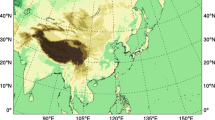Abstract
—A ten-level axi-symmetric primitive equation model with cylindrical coordinates is used to simulate the tropical cyclone evolution from a weak vortex for the Bay of Bengal region. The physics of the model comprises the parameterization schemes of Arakawa-Schubert cumulus convection (Lord et al., 1982) and Deardorff’s (1972) planetary boundary layer. The initial conditions have been taken from the climate mean data for November of Port Blair (92.4 E, 11.4 N) in the Bay of Bengal, published by the India Meteorological Department. An initial vortex has been designed to have tangential wind maximum of 10 m/s at 120-km radius with a central surface pressure of 1008 hPa. As a control experiment, referred to as ASBB1, the model is integrated for 240 h maintaining the sea-surface temperature (SST) constant at 301 K. The results of the control experiment reveal a slow decrease of the Central Surface Pressure (CSP) from the initial value of 1008 hPa to 970 hPa at 156 h. After 156 h the CSP decreased sharply until 186 h, attaining 890 hPa. The tangential wind at 1 km level attained the Cyclone Threshold Intensity (CTI) of 17 m/s around 78 h and a maximum of 87 m/s was found at 210 h. These features indicate a predeveloping stage up to 156 h, a deepening stage of 30 h from 156–186 h followed by the mature stage. The mature stage is characterized by the simulation of the central eye region, warm core, strong cyclonic circulation in the central 300 km with low-level inflow; strong vertical motion at the eye wall and outflow aloft. The convection features of the different cloud types conform with the circulation features. The control experiment clearly indicates the evolution of a cyclone with hurricane intensity from a weak vortex. In part two of the paper, results from sensitivity experiments with respect to variations in latitude, SST and initial thermodynamic state have been presented.
Similar content being viewed by others
Author information
Authors and Affiliations
Additional information
Received July 25, 1998, accepted February 10, 1999
Rights and permissions
About this article
Cite this article
Bhaskar Rao, D., Ashok, K. Simulation of Tropical Cyclone Circulation over Bay of Bengal Using the Arakawa-Schubert Cumulus Parametrization. Part I — Description of the Model, Initial Data and Results of the Control Experiment. Pure appl. geophys. 156, 525–542 (1999). https://doi.org/10.1007/s000240050311
Issue Date:
DOI: https://doi.org/10.1007/s000240050311




